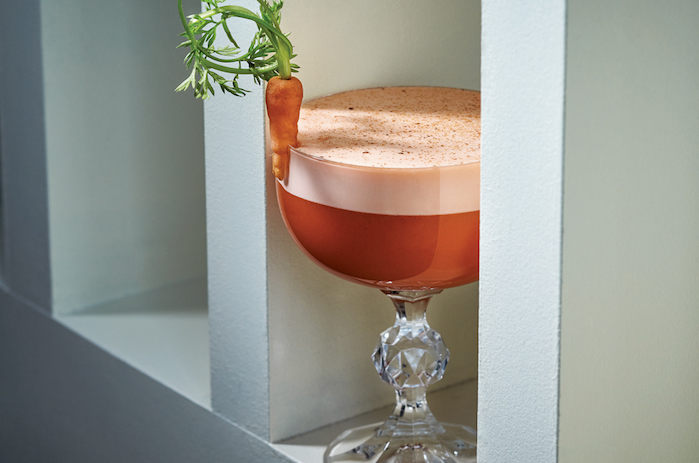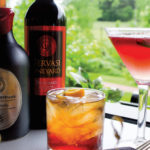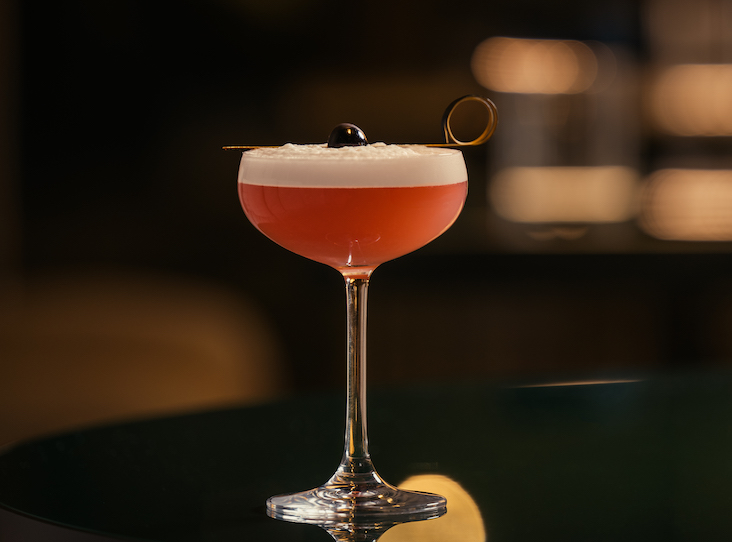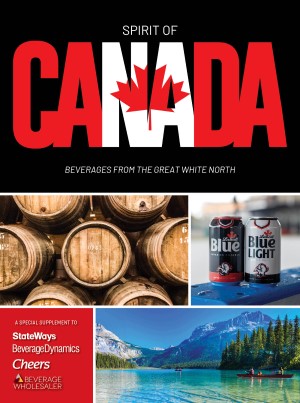We know what wine can add to an orange-juice-filled flute during a lazy weekend brunch, or to a pitcher brimming with sliced fruit and a healthy dose of brandy on a sunny patio. But what about a sherry-based Daisy? Or in an ice-filled glass of tonic that eschews gin for white port? Wine-based libations are hot, hip and what guests are craving, especially in summer swelter when they want to stay refreshed, not wilted.
At Verdigris, a 40-seat, contemporary French restaurant in Portland, OR, a White Port (or White Vermouth) and Tonic ($8) is one of three wine cocktails in the menu. “This is simply the most refreshing drink ever made,” says general manager Sarah Egeland.
She is a fan of fortified wines in cocktails in general, including sherry. “It has such a wide flavor profile to incorporate into a cocktail, ranging from nutty to salty,” Egeland notes. Verdigris’ Maestro cocktail ($11) stirs PX sherry with chamomile-infused bourbon and Amaro Nonino.

The Cobbler cocktail at Arroz in Washington, D.C., is made with Pedro Ximenez sherry, Spanish brandy, rye whiskey and Angostura and orange bitters.
Sherry on Top
For certain, the trend in wine cocktails right now is fortified—and Spanish. “Sherry is a fabulous ingredient in cocktails because of its diversity and wide array of flavor profiles,” says Taha Ismail, beverage director for the 138-seat, Arroz restaurant in Washington, D.C. “The extreme difference between a fino and a PX allows for sherry to be used in many different ways, depending on the ultimate goals for your creation.”
The southern Spanish- and Moroccan-influenced Arroz has five sherry cocktails on the menu priced at $13. All are recreations of classic libations using sherry as a base.
In the Sour, for instance, Lustau Moscatel sherry serves as a sweetener. It’s mixed with white rum, steamed carrot juice, lemon, velvet falernum and egg white, served up in a coupe.
In the Daisy, Lustau palo cortado sherry provides a nuttiness that plays well with mahia, a Moroccan spirit made from figs. The drink also includes ginger and honey syrups and lemon juice and is served in a coupe over a large ice sphere.
Ismail also offers a Fizz, a Martini and a Cobbler; the latter is served with Pedro Ximenez sherry, Spanish brandy, rye whiskey and both Angostura and orange bitters. It’s poured over cobbled ice and garnished with an orange, mint and cherry.
Aperitifs and Accompaniments
Guests at Arroz enjoy sherry cocktails throughout a meal—Ismail likes to pair the Daisy with Arroz’s Iberico meat board or octopus a la plancha with harissa bouillon and saffron aioli. An upcoming sherry riff on the Negroni will stir Cesar Florido fino sherry with Cappelletti and aquavit, and is a lovely aperitif before a meal, Ismail says.
The White Port and Tonic is “also a go-to starter for me, especially when I’m looking for something clean and refreshing, [as] it needs nothing more than a lemon twist,” he adds.
Dan Molitor, director of beverage at Mandalay Bay and the Delano in Las Vegas, cites sherry as a versatile ingredient for cocktails. “Its unique flavor profile and higher-alcohol content provide a rich backbone to any boozy beverage,” he says.
Both of the $16 wine cocktails offered at the 60-seat Franklin Lounge at the Delano feature sherry. The Delano Daiquiri (whose fresh ingredients change seasonally) mixes Lustau Manzanilla sherry with Bacardi 8 Year rum, Clement Mahina Coco coconut liqueur, lime and simple syrup.

Ironside Fish & Oyster’s Toledo Steel cocktail mixes manzanilla sherry with ouzo, lime, grapefruit, sea salt and simple syrup topped with cava.
The Tennessee Valley Cobbler is made with Lustau amontillado sherry, Basil Hayden’s bourbon, Angostura bitters, lemon, berries, peppercorn and honeysuckle sour. “It is a refreshing bourbon cocktail with complex flavors…and a sweet finish,” while the sherry provides a nutty, dry component that gives balance,” says Molitor. He suggests it with the breaded Duroc pork katsu sandwich, served with organic greens and togarashi-spiced yuzu aioli.
Sherry is also the trending ingredient in wine cocktails at Ironside Fish & Oyster in San Diego. A 144-seat contemporary interpretation of the classic fish house and oyster bar, Ironside currently offers seven wine cocktails.
“Sherry adds another acidic layer depending on the [style],” notes bar manager Dean Pryor, “but dry sherry with citrus adds complexity.” The Toledo Steel cocktail ($9) mixes manzanilla sherry with ouzo, lime, grapefruit, sea salt and simple syrup. Served in a coupe topped with cava; dry and refreshing, it pairs well with oysters’ briny tang.
Vermouth and Bubbles
While sherry is definitely a guest favorite right now, Pryor says he is partial to dry and bianco vermouth. “My mentor always told me: Dry vermouth is a suit, sherry is a tuxedo.”
Ironside’s Jimmy Gatz cocktail ($9) has Lillet Blanc vermouth as its base, mixed with lemon and hopped grapefruit bitters, topped with cava and served in a flute. The menu describes it as robust, with white flower notes and a grassy, grapefruit accent.
“Wine helps to build structure and add more intricate flavors in a cocktail,” says Sebastien Vallet, general manager of the 200-seat Skyfall Lounge located at the Delano Las Vegas. “Champagne bubbles add texture, white wine brings dryness or acidity, and sherry brings aromatics and a bit of salt.”
Skyfall Lounge features five wine-centric cocktail, each priced at $16. The Victim of Elegance, a twist on the Aperol Spritz, shakes Dolin dry vermouth with Aperol, strawberry syrup and lemon juice, topped with Champagne Alain Ducasse and garnished with a thyme sprig. The cocktail is a good match for strawberry rhubarb panna cotta, Vallet says.
The Palmetto Rosé shakes Lillet Blanc with fino sherry, Giffard Pamplemousse liqueur and lemon juice, topped with sparkling rosé and garnished with a grapefruit twist. “It’s a fun take on a classic aperitif; it’s elegant and dry, with subtle notes of grapefruit supporting a sparkling rosé base,” Vallet notes.
Bubbles and vermouth play together in the Saffron Cardamom Sparkling Cocktail at Verdigris. Made with saffron and cardamom syrup, lemon, olive oil, Lillet and cava, the drink sells for $9.

The Tropical Sangria at ART is made with freshly squeezed orange and mango juices, peach schnapps and moscato.
Still Wines and Sangrias
Non-fortified wines can be used in cocktails to add a diverse range of flavors and temper the alcohol content, says Richard Sterling, head bartender for the 75-seat ART Burger Sushi Bar in Myrtle Beach, SC. “Taking into account wines that are light-bodied to full-bodied, or dry to sweet, I can put unique spins on them, which opens them up to creativity and making new and exciting drinks,” he notes.
One of his favorites right now is Dosman d’Asti Moscato, which makes cocktails light, refreshing and slightly sweet, Sterling says. Bridgeview pinot noir from Oregon is another: a robust choice with a silky finish that works to mellow out bolder flavors such as acidic orange or grapefruit juice, or intense ginger.
ART Burger Sushi Bar offers five wine cocktails on its list priced from $8 to $10. The Tropical Sangria is made with freshly squeezed orange and mango juices, peach schnapps and moscato.
The Green Tea Sake Mojito adds ginger liqueur and house-made ginger syrup to muddled limes and mint, topped with sake that carries lively notes of tropical and a light and refreshing finish. Sterling suggests pairing it with ART’s spicy firecracker shrimp.
“Low-alcohol-content cocktails are making it easier for people who don’t normally drink cocktails to enjoy choices” without any or much liquor, Sterling points out.
“When creating wine-based cocktails, you have to create something relatable for your guests,” Ismail of Arroz explains. “This may vary depending on where you are geographically; some cities in the U.S. are more welcoming to this style of cocktail.”
Education is also key to getting customers on board. Training staff to help guests see beyond sherry as something their grandparents may have imbibed will challenge them to order outside their comfort zone, Ismail notes.
Wine can add so much flavor to cocktails with just one ingredient—think about all the aromas that jump out of the glass as you swirl and sniff. So less is more, according to Egeland of Verdigris. “I like to keep them pretty simple—let the wine shine through!”
Kelly Magyarics, DWS, is a wine, spirits and lifestyle writer and wine educator in the Washington, D.C. area.







